

(Louis Meulstee’s web site)

Mobile Radio
MOBILE RADIO IN THE NETHERLANDS
A short historical survey of mobile radio developments at KPN Telecom.




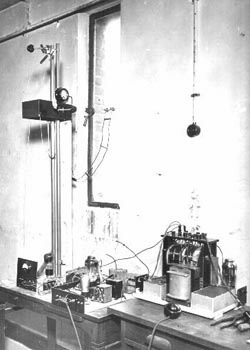
SUMMARY
A brief history of mobile radio developments at the Dutch PTT (the Dutch Post and Telegraph organisation, being privatised some time ago and now "KPN") is given, starting from the mid-thirties through the gradual post-war revival, to the present day. The Dutch National radiotelephone network, inaugurated in 1949, was the world's first nation-wide public radiotelephone system. Some mobile radiotelephones and base stations with significant historical importance are briefly discussed. Although specialised mobile radio equipment was developed and made for PTT by the industry at home, much material was (and still is) acquired from manufacturers abroad. Until the privatisation in the late 1980's, the exploitation of private and public networks and mobiles differed from that used in other countries.
Note that the old name PTT has been used throughout this survey since most of the contents are dealing with the days before the privatisation and consequent later renaming of the company into KPN.
This survey was originally written in 1992. As many, many, major changes occurred within the company in the following years, some statements are now outdated. I did, however, not alter the original text as it only covers the period up to the late 1980’s.
(1934) Experimental base station developed by the Dutch PTT radio laboratory, installed in the attic of the PTT GHQ building in The Hague. Note the use of symmetrical feeder line through the glass window to the aerial system.
INTRODUCTION
During the early 1930s the Radio Controle Dienst (Dutch FCC), a department of PTT, operated a number of radio direction finder (RDF) vehicles in order to locate clandestine broadcast transmitters. Communication between the RDF parties, needed in order to exchange cross bearings, was by telephone only, and often resulted in long delays.
Designs of simple 5 metre superregenerative equipment, as published in the American radio amateur magazine QST, brought attention to the problem and eventually a solution appeared.
In 1934, the Dutch PTT radio-laboratory was asked to provide two of these sets for radio-communication between RDF vehicles. The trials with the rather crude and simple sets were successful, especially because the required operating ranges generally did not exceed more than a few miles.
THE EARLY YEARS
The trials which involved demonstrations for other potential users, roused much interest. In 1936-37 a national commission, in which PTT and representatives of police, fire brigade etc. took part, laid down specifications for a more practical radio-telephone operating on VHF. The national industry was invited to produce a prototype of this equipment. Of the eight manufacturers who participated, the design of the Nederlandse Seintoestellen Fabriek (NSF), a subsidiary of Philips-Eindhoven, was chosen as most suitable. A prototype was tried early in 1938, and the first sets of a series of 200 were delivered mid-1939. The NSF design came in two versions: a mobile station DR38a operating from a 6 volt vehicle battery and a fixed station FR38a powered by AC mains, the only difference being the built-in power supply unit. Special features were the Kolster automatic frequency compensating circuit of the transmitter master oscillator and RF amplifier in front of the super-regenerative detector. The design resulted in a highly successful set. Most of the DR/FR38a equipment went to large municipal fire brigades, ambulances and police. A number of the sets were reserved for internal use by the Dutch FCC. A special FCC branch arranged for the installation and service of the radiotelephones. During the mobilisation of the armed forces due to the outbreak of hostilities in Europe, a number of sets were commandeered by the Dutch War Office.

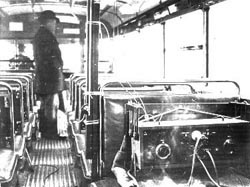
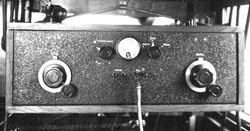

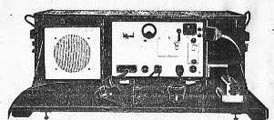
(1935) The early years. Trials with a PTT VHF radiotelephone installed in a city bus. Having a separate receiver and transmitter, provision was made for full duplex operation.
RAF type TR1184a. Compare this set with the DR38a pictured left.

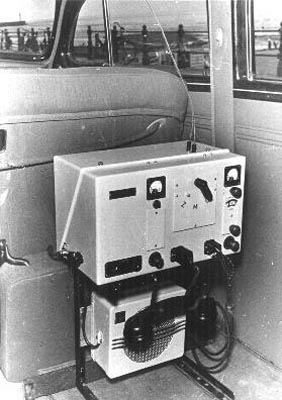
GERMAN OCCUPATION
When the Germans invaded the country in May 1940, during the early morning following the capitulation, the DR38a/FR38a sets were requisitioned and taken to Germany. It is interesting to note that a number of the sets were used for short range communication by the German security force "Ordnungs-Polizei".
REVIVAL
After the liberation by the Allies in May 1945, much effort was made to restore the heavily damaged communications network in the country. This was not an easy task as many of telephone exchanges were either looted or seriously damaged by the retreating Germans. On top of this was a virtually wrecked railway system, large numbers of destroyed bridges, and a waterflooded countryside which made travelling very difficult. The Government in exile (in London) had already taken steps to prepare for such a situation and had ordered from the USA 200 VHF FM radiotelephones for fixed service. As it was anticipated that the Germans would destroy all telephone exchanges in the country at their retreat, the initial plan was to built an emergency radio-network based on the telephone trunk network. Therefore, frequencies were ordered for a star-shaped net, with extensions to local networks. However, in 1945, knowing that many exchanges had survived, the plan was abandoned and the 200 Government sets were put in the hands of the Dutch PTT (to whom, later, the bill was presented....). It was then decided to use the sets for vital interim communication at places where telephone lines and exchanges had been put out of action. Within a few months, a number of these radiotelephones were installed, providing point to point communication until line communication had been restored for a variety of official organisations including the War Office.
NSF Type DR38a transmitter receiver was the first practical mobile radio telephone in Holland. The set was developed in 1937 from PTT specifications and saw use from 1939 onwards. It operates in the frequency range between 66-75 MHz having a RF power output of approximately 4-5 Watts. Change-over from receive to transmit is effected by the large lever on the front panel. The transmitter is pre-set on a single frequency while the receiver is tunable over the frequency range.
BALLOON COMMAND
Not only the Germans used the DR38a and FR38a. For low-power transmission over a limited area the British Balloon Command used RAF T.R. 1148a transceivers which were virtually identical to the Dutch Philips sets differing only in minor details. Apparently, the sets were produced by a subsidiary of Philips in England. No further information, however, is known at present.

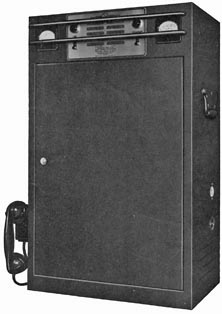
Link type 1498

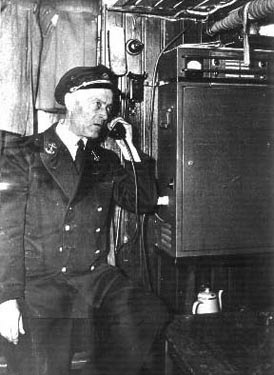
"LINK" EQUIPMENT
The American equipment was affectionately known as "Link" sets, named after the manufacturer Fred M Link Radio Corporation. Service and alignment of the Link sets appeared to be straightforward as the equipment was built in an easy accessible rack, comprising separate units. Their installation, however, was a difficult task for the PTT employees concerned, because of the bad roads, insufficient clothing and food, and bad accommodation. Nevertheless, in September 1945 more than 50 Link sets were installed, all giving much satisfaction to their users. The Link Type 1498 transmitter-receiver and associated Type 1504 remote control unit remained in service by the Dutch PTT until the early 1960's; the author recalls having seen Link remote control units in operational use as late as 1967. The equipment was not only used as base stations; it is recorded that the Link sets had been installed in icebreakers operating on the major Dutch waterways and tug-boats in the harbour of Rotterdam.
NATIONAL PUBLIC NETWORK
After the conspicuous successes of the initial Link nets, the equipment started to be used for commercial private networks. Additionally, a growing need was felt for a nation-wide public radio network, connecting a mobile to any telephone-subscriber.
As early as 12 April 1949 the first base station in the first phase of the National Public Network was inaugurated, using two semi-duplex radio channels with frequencies repeated throughout nation-wide installed Link type 1498 base stations. Additional separate receivers were installed to increase coverage in rural areas.
THREE MINUTES
When making a radio-telephone call, the subscriber drawed the operator's attention by pressing the microphone button for approximately five seconds. After requesting the mobile's identification number and telephone number called, the operator closed down, calling the mobile again when the connection had been completed. Calling a mobile by dialling the 005 National Public Network operator was a bit more complex. The operator needed the approximate whereabouts of the mobile. A mobile was expected to switch to the frequency of the nearest base station. Additionally he had to listen to the traffic until his number was announced by the operator. Due to the relative small number of base stations, the duration for a call was limited to only three minutes. Within a few years, the traffic load had grown gradually and further expansion was urgently needed.
SECOND PHASE
During the second phase, in 1955, the National Public Network was expanded with six frequency channels. In close co-operation with Philips Telecommunications Industries ,-PTI, formerly NSF, new equipment was developed, comprising custom-made base stations, telephone terminal equipment and eight channel mobiles. The new eight channel network provided an improved nation-wide coverage having almost doubled the number of base stations.
(1947) Link set in operational use on board a vessel. Not being specially designed as a mobile station and operating on 110 volt ac only, it was powered from a special generator or by a separate petrol electric generator. One particular sentence in the US War Department handbook of the set is very striking, and has never been repeated in any US Signal Corps handbook : "...the equipment utilises the Armstrong frequency-modulation method of transmission and reception..." giving credit to the inventor of frequency modulation.

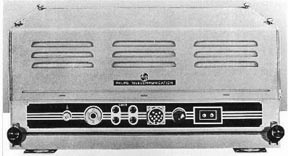
The Philips type SRR192 was the first Dutch post-war mobile radio telephone using frequency modulation. (1949) It operates on two crystal controlled channels in the frequency range of 70-87.5 MHz having a RF output of 15-20 watts. The Dutch PTT primary used the set during phase 1 in the National Network. The transmitter receiver unit was usually installed in the back of the vehicle, the control unit mounted under the dashboard.

Link Type 1498 transmitter receiver manufactured from 1943 onwards by Link Radio Corporation, was the backbone of the post-war (mobile) radio communication in the Netherlands. It proved to be of much value especially in the early months after the liberation of the country, where the sets were used for vital point to point communication, at times being the only means of communication. The set had a RF output of approximately 50 watts and operated on one fixed crystal controlled channel in the range of 70-100 MHz. The equipment proved to be very reliable and is recorded to have been used up to the early 1960's. In this picture are two Link base stations of the Dutch phase 1 National Public Network, installed in the main Post Office of Rotterdam. Special PTT developed audio automatic gain control amplifiers were mounted in trays below the Link sets.
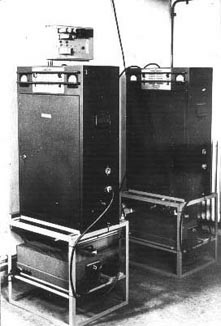

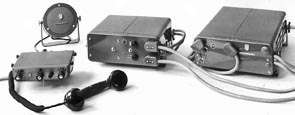
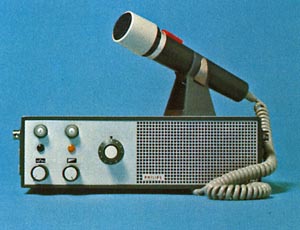
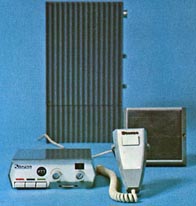

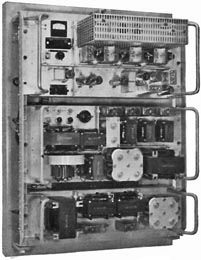
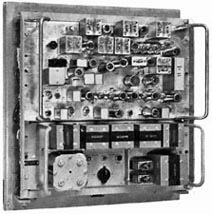
Philips type SRR296 (above) and type ZPH were later generations of mobiles for subscribers of the National Public Network.
In the early 1970s a new range of fully transistorised mobile subscriber equipment was introduced: Philips CMT (above) and Storno CQM600 (below).
Philips type 8RZ650 transmitter (above) and type 8RO650 receiver (below), affectionately known as ‘SQ’ equipment, were base stations used with the National Public Network from the early 1960’s onwards until the closure of the network in 1985.
MOBILIFOON DIENST
In 1950 the special FCC department changed to a special nation-wide PTT department ‘Mobilofoon Dienst’ with about 17 countrywide branches. This organisation exists until the present day, though some time ago being split up into various departments, of which the author is employed at the department dealing with private radio networks, public trunking and mobile radio solutions known as ‘Business Radio Solutions’.
THE END OF THE NATIONAL NETWORK
The operator controlled National Public Networks were expanded in the late 1960s by a large number of channels and base stations and Regional Public Networks in Amsterdam and Rotterdam, the latter affectionately known as ‘Harbour Radio’. Philips type 8RO650 and type 8RZ650 equipment, was used as replacement for the by then antiquated and worn out Link sets. In the late 1970’s, as a stopgap, Storno CQF600 base stations were installed. The hand operated system National Public Network was closed in 1985.
DIRECT DIALLING
For cost saving reasons no attempts were made to provide direct dialling and selective calling as used in some European countries at that time. A PTT developed experimental direct dialling system, actually an improved version of the Regional Public Network, installed in the early 1970s in Rotterdam, was highly satisfactory. It was closed in 1980 when a fully automatic radiotelephone network known as ‘ATF1’ became operational. This network, abandoned several years ago, was compatible with the German, Luxembourg and Austrian Obl-B net, thus having a semi-European coverage. A second direct dialling network ATF2 (cellular), operating on 460 MHz and a third ATF3 (cellular) network working on 900 MHz, were installed in the 1980s and eventually abandoned in the mid 1990s as result of the success of the GSM networks which became available in the 1990s.
EXPLOITATION
At the time, in most countries public radiotelephone networks were exploited by the Government (usually a PTT or the Post & Telephone administrations). Approved mobiles were sold to subscribers by a third party, usually a manufacturer or agent. Until some years ago (with privatisation) the Dutch PTT considered a mobile more or less as an extension of a telephone trunk. A subscriber was only allowed to hire equipment of PTT. The advantages of hiring a mobile --low initial costs and no obligation to continue when no longer needed-- made the National Public Network very popular in those days.

Holland, a country with many rivers and canals, many subscribers of the National network were owners of inland freight vessels. One unhappy day, a Master had a set installed and proudly made his first radio telephone call to his wife. As he was rather far away from the nearest base station, the conversation faded away now and then. On one occasion the wife of the Master said:" I can't hear you anymore, Dear", to which the helpful operator coming into the line saying:" Your husband is sinking away, Madam". The reaction was a loud cry, then silence..



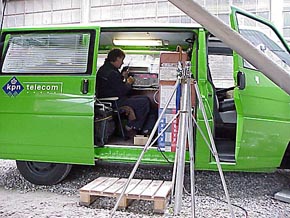
PRIVATE MOBILE RADIO NETWORKS
Next to the National and Regional Public Networks, a considerable number of commercial private mobile radio networks have been installed by the Dutch PTT. Equipment manufactured by a variety of manufacturers, depending the customer's operational demands, has been used throughout the years. In this field KPN still works closely with the international manufacturers: e.g. in the early 1980's the versatile Condor 16 radiotelephone was developed to PTT specifications. In the recent years KPN developed and installed large maritime VHF radio networks along the river Maas extending to Rotterdam, the Schelde estuary from the North-sea towards Antwerp and the VHF coastguard radio network.
In addition large nation-wide networks were delivered providing complex communication facilities for Dutch Rail and for breakdown-service patrols of the Royal Dutch Tourist association ANWB, the Dutch Police, Rotterdam and Amsterdam Public Transport and Schiphol Airport, just to name a few.
The author at work: RF field strength measurements for a proposed MPT 1327 trunked radio system.
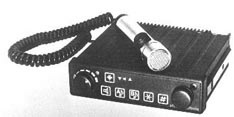
CONCLUSIONS
After a slow initial start, the number of radiotelephones increased considerably, having a remarkable resemblance to the growth of radio-telephones in the USA, with a time-lapse of approximately 10 years. In 1950, the year of the completion of the Dutch National network, the world's first public mobile radio network offered a complete nation-wide coverage. This was, of course, not only due to the innovative work of PTT, but also the fact that Holland is a relative small country and has a fairly flat surface. PTT, independent from the early days until the present, purchased equipment either to specifications laid down by PTT, or use standard equipment adopted for PTT use.
ACKNOWLEDGEMENTS
Thanks are due to the late Mr H.Lubsen, for his information on early developments, without his help this paper could not have been so complete and accurate. I also wish to thank Mr J.W.M.Caspers formerly of the Museum voor Communicatie , The Hague, Holland, who kindly provided historical information and many of the photographs published in this article.
PAGING
In December 1955, PTT opened an experimental selective paging system to investigate the possibilities of such a system. The success of the trials led to the inauguration of the SEMAPHONE a nation-wide selective paging system, the first of its kind in the world. The development and history of this system may be subject for a forthcoming web page.

This historical survey has been published previously in:
- RADIO BYGONES, June/July 1994, pp10-15.
- Proceedings of the Radio Club of America, Vol. 66, No. 1, May 1992.
REFERENCES
- Instruction book Radio Transmitter-Receiver Type 1498 and associated equipment, Link Radio Corporation, NY, February 1943.
- Type DR38-FR38, Technical description and working instructions, NSF, Hilversum, Holland, 1939.
- Air Publication No. 1186a, Sec. 2, Chap. 6, (AL28), n.d.
- Radio Paging in the Netherlands, Louis Meulstee, Proceedings of the Radio Club of America, Vol. 66, No. 3, Nov 1992.
- Fixed Radio Service in the Netherlands, Louis Meulstee, Proceedings of the Radio Club of America, Vol. 67, No. 1, May 1993.

Disclaimer: the contents of this page is not official KPN Telecom. It comprises principally privately collected information about the history of the ‘Mobilofoon’ department where I was employed until my retirement. See also the official KPN web-site www.kpn.com

 Top of page
Top of page
(1981) The ‘Condor 16’ mobile radio was developed exclusively for PTT Telecom. This set was primarily used in private networks It operates on VHF or UHF, depending the model, having 80 radio channels.